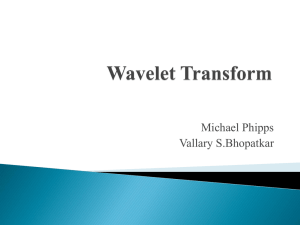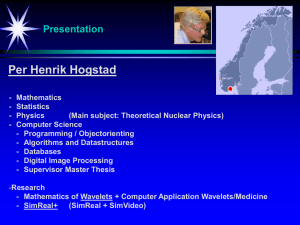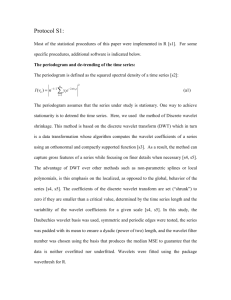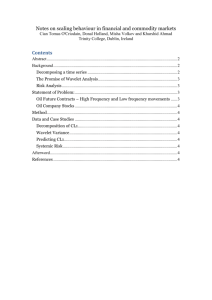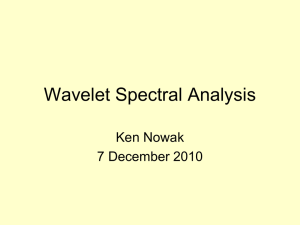Support Vector Machine(SVM) Classifier for Voltage Disturbances
advertisement
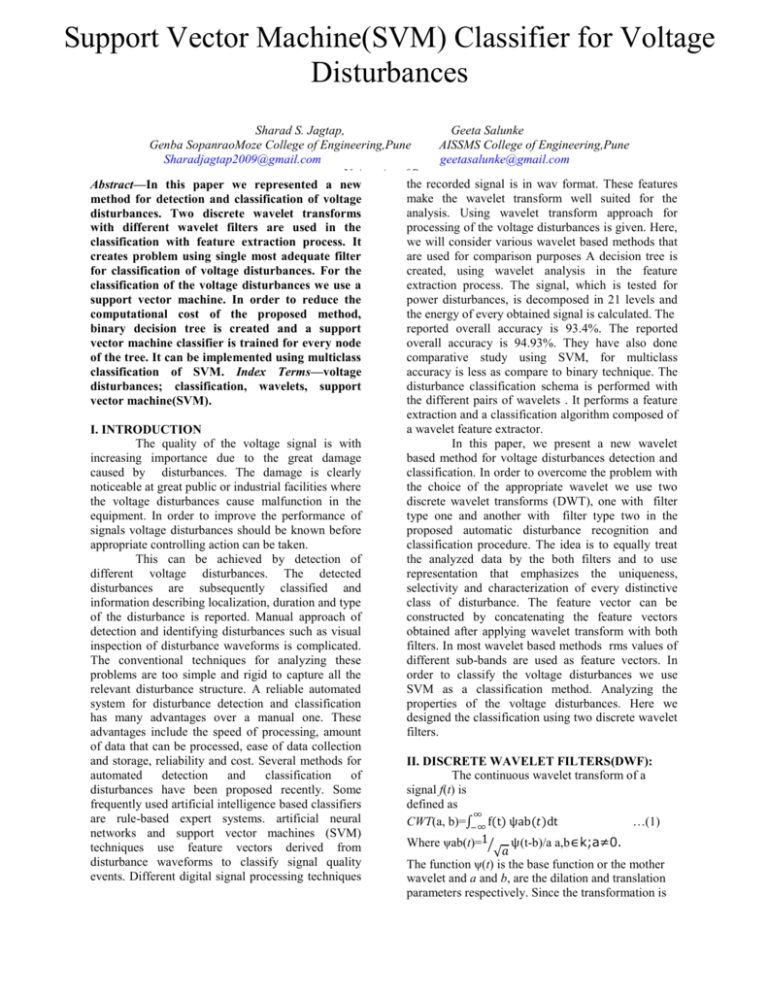
Support Vector Machine(SVM) Classifier for Voltage
Disturbances
can be used in the process of xtraction featuresthat
characterize PQ disturbances [3]. Among them,
wavelettransform
has been used extensively in the
Sharad S. Jagtap,
Geeta Salunke
transform
analysis approach is
Genba SopanraoMoze College of Engineering,Punelast years.Wavelet
AISSMS College
of Engineering,Pune
able
to
giveinformation
about
frequency
contents of
Sharadjagtap2009@gmail.com
geetasalunke@gmail.com
University of Pune
the recorded signal is in wav format. These features
Abstract—In this paper we represented a new
make the wavelet transform well suited for the
method for detection and classification of voltage
analysis. Using wavelet transform approach for
disturbances. Two discrete wavelet transforms
processing of the voltage disturbances is given. Here,
with different wavelet filters are used in the
we will consider various wavelet based methods that
classification with feature extraction process. It
are used for comparison purposes A decision tree is
creates problem using single most adequate filter
created, using wavelet analysis in the feature
for classification of voltage disturbances. For the
extraction process. The signal, which is tested for
classification of the voltage disturbances we use a
power disturbances, is decomposed in 21 levels and
support vector machine. In order to reduce the
the energy of every obtained signal is calculated. The
computational cost of the proposed method,
reported overall accuracy is 93.4%. The reported
binary decision tree is created and a support
overall accuracy is 94.93%. They have also done
vector machine classifier is trained for every node
comparative study using SVM, for multiclass
of the tree. It can be implemented using multiclass
accuracy is less as compare to binary technique. The
classification of SVM. Index Terms—voltage
disturbance classification schema is performed with
disturbances; classification, wavelets, support
the different pairs of wavelets . It performs a feature
vector machine(SVM).
extraction and a classification algorithm composed of
a wavelet feature extractor.
I. INTRODUCTION
The quality of the voltage signal is with
In this paper, we present a new wavelet
increasing importance due to the great damage
based method for voltage disturbances detection and
caused by disturbances. The damage is clearly
classification. In order to overcome the problem with
noticeable at great public or industrial facilities where
the choice of the appropriate wavelet we use two
the voltage disturbances cause malfunction in the
discrete wavelet transforms (DWT), one with filter
equipment. In order to improve the performance of
type one and another with filter type two in the
signals voltage disturbances should be known before
proposed automatic disturbance recognition and
appropriate controlling action can be taken.
classification procedure. The idea is to equally treat
This can be achieved by detection of
the analyzed data by the both filters and to use
different voltage disturbances. The detected
representation that emphasizes the uniqueness,
disturbances are subsequently classified and
selectivity and characterization of every distinctive
information describing localization, duration and type
class of disturbance. The feature vector can be
of the disturbance is reported. Manual approach of
constructed by concatenating the feature vectors
detection and identifying disturbances such as visual
obtained after applying wavelet transform with both
inspection of disturbance waveforms is complicated.
filters. In most wavelet based methods rms values of
The conventional techniques for analyzing these
different sub-bands are used as feature vectors. In
problems are too simple and rigid to capture all the
order to classify the voltage disturbances we use
relevant disturbance structure. A reliable automated
SVM as a classification method. Analyzing the
system for disturbance detection and classification
properties of the voltage disturbances. Here we
has many advantages over a manual one. These
designed the classification using two discrete wavelet
advantages include the speed of processing, amount
filters.
of data that can be processed, ease of data collection
and storage, reliability and cost. Several methods for
II. DISCRETE WAVELET FILTERS(DWF):
automated
detection
and
classification
of
The continuous wavelet transform of a
disturbances have been proposed recently. Some
signal f(t) is
frequently used artificial intelligence based classifiers
defined as
∞
are rule-based expert systems. artificial neural
CWT(a, b)=∫−∞ f(t) ψab(𝑡)dt
…(1)
networks and support vector machines (SVM)
Where ψab(t)=1⁄ ψ(t-b)/a a,b∈k;a≠0.
techniques use feature vectors derived from
√𝑎
disturbance waveforms to classify signal quality
The function ψ(t) is the base function or the mother
events. Different digital signal processing techniques
wavelet and a and b, are the dilation and translation
parameters respectively. Since the transformation is
achieved by dilating and translating the mother
wavelet continuously, it generates substantial
redundant information. The resulting expression is
given
with
∞
𝑚
𝟏
𝑘 − 𝑛𝑏0 𝑎0
𝐃𝐖𝐓[𝐦, 𝐧] =
∑ 𝒇[𝒌] ψ[
]
𝒎
𝑎0𝑚
√𝒂𝒐 𝒌=−∞
Input Voltage Signal
Discrete wavelet
transform using filter
type one
Compute rms value
Discrete wavelet
transform using
filter type two
Compute rms value
concatenaterms values
Feature vectors
Fig.1 Generation of Feature Vector
Wavelet transform is called a dyadic-Ortho
normal wavelet transform, and can be easily and
quickly implemented by filter bank techniques
normally known as Multi-Resolution Analysis
(MRA) which consists of two filters: a high-pass
filter with impulse response h[n] i.e.Ca1 and its lowpass mirror version with impulse response g[n]i.e.
Cd1. These filters are related to the type of mother
wavelet and can be chosen according to the
application. At each stage, the input signal is
decomposed for low pass and high pass conditions.
The approximation signal is further decomposed to
produce new coarser representation of the signal.
After specific levels of decomposition, we can get
two parts after feature extraction, which is the
reference signal at the next higher resolution.
III. SUPPORT VECTOR MACHINES (SVM) :
The support vector machine (SVM) is a
powerful method for statistical classification of data
used in a number of different applications. However,
the usefulness of the method in a commercial
available system is very much dependent on whether
the SVM classifier can be pre trained from a factory
since it is not realistic that the SVM classifier must
be trained by the customers themselves before it can
be used. This paper proposes a novel SVM
classification system for voltage disturbances.
Support vector machines are a very popular
supervised machine learning methods used for
classification and regression analysis. Given a set of
n training examples xi which belong in one of two
classes ci ={-1,1} using SVM we can create a model
which can separate new samples of the classes. The
task of the classification process is to choose a hyper
plane which can best separate the two classes. The
hyper plane is described as
𝑃0 : 𝑤. 𝑥 − 𝑏 = 0
Where wx denotes the dot product and w the normal
vector to the hyper plane. The parameter b / w
determines the offset of the hyper plane from the
origin along the normal vector w. We want to choose
the parameters w and b to maximize the margin, or
distance between the parallel hyper planes that are as
far apart as possible while still separating the data.
These hyper planes can be described by the
equations:
𝑃1 : 𝑤. 𝑥 − 𝑏 = 1
𝑃2 : 𝑤. 𝑥 − 𝑏 = −1
The problem can be solved by minimizing
1
||𝑤 2 ||
2
P1
P0
P2
Ca2
S
Cd3
Ca1
Cd2
Ca3
Cd1
Fig.2Feature extraction using three levels.
Fig.3 Support vectors and hyper plane.
Table-I Voltage disturbances equations
Type of disturbance
NORMAL(C1)
SWELL(C2)
SAG(C3)
HARMONIC(C4)
Function/Model used
x(t) = sin 𝑤(𝑡)
x(t) = A(1 + α(u(t − t1) − u(t − t2)))sin 𝑤(𝑡)
x(t) = A(1 − α(u(t − t1) − u(t − t2)))sin 𝑤(𝑡)
x(t) = A(𝛼1 sin(𝑤𝑡) + 𝛼3 sin(3𝑤𝑡) + 𝛼5 sin(5𝑤𝑡) + 𝛼7 sin(7𝑤𝑡))
Parameters
0.1≤α≤0.8,T≤t2-t1≤9T
0.1≤α≤0.8,T≤t2-t1≤9T
0.05≤α3≤0.15,0.05≤α5≤0.15,0.
05≤α7≤0.15,∑ 𝛼𝑖 2 = 1
OUTAGE(C5)
0.9≤α≤1,T≤t2-t1≤9T
x(t) = A(1 − α(u(t − t1) − u(t − t2)))sin(𝑤𝑡)
SAG WITH
0.1≤α≤0.9,T≤t2-t1≤9T
𝑥(𝑡) = A(1 − α(u(t − t1) − u(t − t2)))(𝛼1 sin(𝑤𝑡)
HARMONIC(C6)
0.05≤α3≤0.15,0.05≤α5≤0.1,
+ 𝛼3 sin(3𝑤𝑡) + 𝛼5 sin(5𝑤𝑡))
∑ 𝛼𝑖 2 = 1
SWELL WITH
0.1≤α≤0.9,T≤t2-t1≤9T
𝑥(𝑡) = A(1 + α(u(t − t1) − u(t − t2)))(𝛼1 sin(𝑤𝑡)
HARMONIC(C7)
0.05≤α3≤0.15,0.05≤α5≤0.1,
+ 𝛼3 sin(3𝑤𝑡) + 𝛼5 sin(5𝑤𝑡))
∑ 𝛼𝑖 2 = 1
where diji
n… is the wavelet detail coefficient
in the wavelet decomposition from level 1 to level n
IV. PROPOSED METHOD
For the feature extraction process we use
and aij is the wavelet approximation coefficient in
two DWT, as used in[1] and [2]. The DWT has been
the wavelet decomposition at level n. N is the total
used intensely for the analysis of the voltage
number of wavelet coefficients at each level of
disturbances, compared to the discrete Fourier
decomposition, EDi is the energy of detail
transform (DFT), since it provides not only frequency
coefficients at the decomposition level i and EAl is
information, but also information about location of
the energy of the approximate wavelet coefficients at
the components. The wavelet analysis is in fact a
decomposition level n. In this way, the size of the
measure of similarity between the basis function
analyzed data is significantly reduced The overall
(wavelets) and the signal itself. Therefore, the
feature vector is obtained after applying another
selection of the most adequate wavelet mother
wavelet transform and calculation of the energy of
function to be used in the analysis is one of the key
detailed and approximation coefficients in the same
factors in successful application of wavelets, not only
manner. With aim to make length of the feature
in power quality applications. In order to reduce the
vector and computational cost comparable with other
influence of the choice of the wavelet we propose the
wavelet based methods for detection and
use of two DWT with two different wavelets, one
classification of voltage disturbances Although there
with high support and one with low support.
are many classification methods we have chosen
Introducing the second wavelet transform in the
SVM learning method. We have constructed binary
feature extraction process provides additional
decision tree shown onFig.4, where for every node a
information about the analyzed signal, which makes
liner-SVM model is created. The tree is designed
the classification more accurate.
analyzing the properties of the seven signals. At the
The increased accuracy comes with the price
root node we have grouped the seven types of signals
of increased computational complexity of the
into two groups in such way that they would be
algorithm. However, the additional wavelet transform
easiest to separate. In the first group are the signals
allows fewer levels of decomposition to be used,
without harmonic disturbances and in the other with
which reduces the computational complexity of the
harmonic disturbances. Grouping the signals into two
algorithm. Additionally, we design a classification
groups in a way that will make the classification
algorithm which also reduces the number of
easiest. At the leaf nodes the algorithm separates the
operations in the test phase. The signal, which is
signals which are hardest to separate. The results with
tested for PQ disturbances, is first decomposed in nthe use of the decision tree are similar with the results
levels using discrete wavelet transform. The energy
using the typical one-against-all or one against-one
of the detail and approximation coefficients at each
approach. However, in the testing phase only three
level of decomposition is used as feature vector using
decisions are made instead of seven, thus making this
2
approach faster. The experimental results shown high
formula, 𝐸𝐷𝑖 = ∑𝑁
𝑖 = 1……𝑛
𝑗=1 𝑑 𝑖𝑗
𝑁
accuracy in classification with training data from one
power network and unseen testing data from another.
𝐸𝐴𝑖 = ∑ 𝑎2 𝑖𝑗
High accuracy was also achieved when the SVM
𝑗=1
classifier was trained on data from a real power
network and test data originated from synthetic data.
V. EXPERIMENTAL RESULTS
For comparison purposes the power disturbances are
Table II(a):
Wavelet
Coif 2
Coif30
Db2
Db20
Overall
91.53% 92.53% 92.60% 92.8%
Efficiency
Table II(b):
Db2 Db6 Coif2 Dmey V24 Db20
Class1 100 100 100
100
100 100
Class2 100 100 100
98
100 100
Class3 89
92
90
85
88
90
Class4 100 100 100
100
100 100
Class5 88
91
89
87
90
88
Class6 100 100 100
100
100 100
Class7 100 100 100
97
100 100
VI. EXPERIMENTAL RESULTS
All these worksinclude the same disturbance
types and the same patternnumbers generated by
parametric equations of data(Table. I) for training
and testing of the classification stage.Seven different
classes are considered, including the casewith no
power
disturbances:
normal,
swell,
sag,
harmonic,outage, sag with harmonic and swell with
harmonic,denoted with C1, C2, C3, C4, C5, C6, C7,
respectively. Tencycles are included in every signal
with a samplingfrequency of 256 samples/cycle i.e.
every signal has 2560samples. The normal frequency
is assumed to be 50Hz.The data sets with same size
were used in the testingprocess.The choice of the
number of decomposition level nhassignificant
influence on the process of classification.
Table III:
Db2 Db4
Coif30 Db6
Db6 Db20
&
&
&
&
&
&
coif
coif3
db6
V24
V24 Coif
2
0
20
C1 100
100
100
100
100 100
C2 100
100
100
98
100 100
C3 90
92
94
89
90
91
C4 100
100
100
100
100 100
C5 89
90
92
88
89
90
C6 100
100
100
100
100 100
C7 100
100
100
97
100 100
Choosing higher nwill, generally, bring more
information inthe system and in that way higher
accuracy. On the otherhand, higher number of
decompositions means morecalculations Since two
DWTsare used for extraction of feature vectors in the
proposedmethod we reduce the level of
decomposition
to
n=7.wavelet
transforms
withdifferent wavelets are applied,significant
improvements in the classification processes
areobtained. Some of obtained results are given in
TablesII(a) & II(b).These results have very high
classification accuracy rate.The results also show that
the filter v24, which is mainlyused for harmonic
analysis [3], is not appropriate db4 wavelet in 10 and
12
levels,
respectively
The
results
are
comparativelypresented in Table IIItheperformance
of
the
proposed
wavelet
classification
methodsexceeds the performance of the classification
methodsproposed in [1]–[3].In order to analyze the
computational complexity of theproposed method we
analyze the number of support vectorsobtained in the
training process. The classification functionof the
linear SVM is
𝑚
𝑓(𝑥) = 𝑠𝑖𝑔𝑛(∑ 𝛼𝑖𝑦𝑖 𝑥𝑖 𝑇 𝑥 + 𝑏)
𝑖=1
wherexi are the support vectors and m is the number
of thesupport vectors. It can be seen that the number
of operationsdepends of the number of the support
vectors. It can be seen that due to the correctgrouping
of the signals in most cases the classification isvery
easy and the SVM requires very few support
vectors.The number of support vectors is largest for
the SVM thatdistinguishes the sags from the outages.
However, the proposed classification method does
not useall of the support vectors for a given test
sample and in thecase when the signal is not sag or
outage the number ofcalculations is significantly
reduced.
VII. CONCLUSIONS
This paper proposes a novel method based
on the SVM algorithm for classification of common
types of voltage disturbances.The results from the
conducted
experiments
have
shown
high
classification accuracy, implying that the SVM
classification technique is an attractive choice for
classification of this type of data using DWT and
support vector machine. Highclassification accuracy
rate of the proposed method is obtained by the use of
two wavelets.
VIII. REFERENCES
[1] T. K. A. Galil, M. Kamel, A. M. Youssef, E. F. E. Saadany, M.
M. A.Salama, “Power quality disturbance classification using the
inductiveinference approach”, IEEE Trans. Power Delivery, vol.
19, no. 10,pp. 1812–1818, 2004.
[2] H. He, J. A. Starzyk, “A self-organizing learning array system
forpower quality classification based on wavelet transform’, IEEE
Trans. Power Delivery, vol. 21, no. 1, pp. 286–295, 2006.
[3] M. Uyara, S. Yildirima, M. T. Gencoglub, “An effective
waveletbasedfeature extraction method for classification of power
qualitydisturbance signals”, Journal Electric Power System
Research, vol.78, pp. 1747–1755, 2008
[4] B. E. Boser, I. Guyon, V. Vapnik, “A training algorithm for
optimalmargin classifiers”, in Proc. of the Fifth Annual Workshop
onComputational Learning Theory, ACM Press, 1992, pp. 144–
152.
[5]Milchevski,”Classification of power quality disturbancesusing
DWT and SVM” ISSN 1392-1215, VOL. 19, NO. 2, 2013



